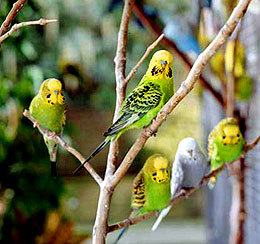Choosing a Pet Budgie: Age Characteristics
Ownership of pet birds varies throughout the world but, undoubtedly, the most popular species are the budgerigar (budgie) and the canary.
Budgerigars make cheerful and charming companions and are easy to look after. They are by no means expensive to feed or maintain. They enjoy family life and they can live fairly long. Seven years is about average, but there have been cases of budgerigars living 20 years or more.

As with any other pet, it is important to take some time and choose a healthy bird that has been well bred. Obviously you should look to a good source when acquiring your new pet, such as a reputable breeder or a good pet shop. If you are in any doubt about where to buy your bird or what sort to choose, your veterinarian should be able to advise you, and also tell you about reputable breeders in your area. A healthy bird should be lively and alert, have a good plumage, with all its tail feathers intact and a clean vent region.
If you want your bird to talk, you should choose a young cock or hen between 6 and 9 weeks old. Young budgerigars in particular are easy to identify, as they have certain identifiable characteristics. A young budgerigar does not have clearly defined throat spots, has striations across the front of his mask (face) and has flecking on the bib of the mask. Young cocks have a bold, purplish cere and hens have a blue-white cere. They do not have a white ring around the eyes at this age, so the eyes appear large and black. At around 12 weeks of age, the baby feathers are moulted to make way for the adult plumage. The cock bird's cere changes to a shiny deep blue and the hen's to a definite brown. Both sexes develop a white outer ring around the eyes. Once a budgerigar has grown adult feathers, it is impossible to tell its age unless it is wearing a closed, dated leg-ring fitted by the breeder.
[ Search Articles ] [ Article Index ]
